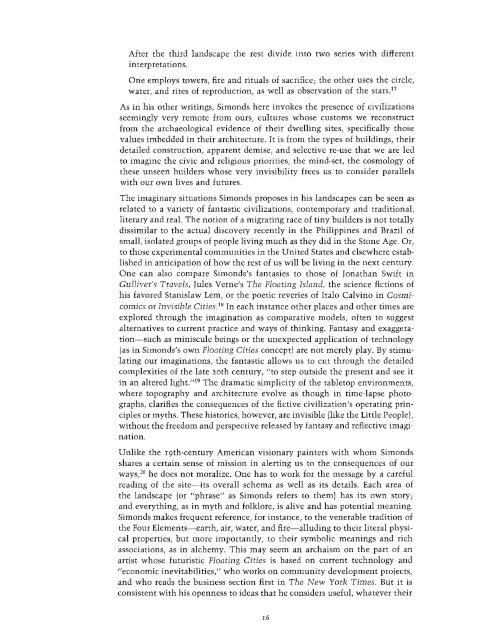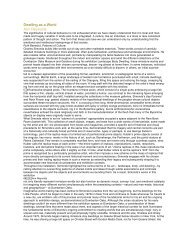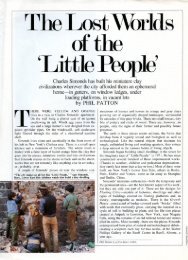Read Catalog - Charles Simonds
Read Catalog - Charles Simonds
Read Catalog - Charles Simonds
Create successful ePaper yourself
Turn your PDF publications into a flip-book with our unique Google optimized e-Paper software.
After the third landscape the rest divide into two series with different<br />
interpretations.<br />
One employs towers, fire and rituals of sacrifice; the other uses the circle,<br />
water, and rites of reproduction, as well as observation of the stars. 17<br />
As in his other writings, <strong>Simonds</strong> here invokes the presence of civilizations<br />
seemingly very remote from ours, cultures whose customs we reconstruct<br />
from the archaeological evidence of their dwelling sites, specifically those<br />
values imbedded in their architecture. It is from the types of buildings, their<br />
detailed construction, apparent demise, and selective re-use that we are led<br />
to imagine the civic and religious priorities, the mind-set, the cosmology of<br />
these unseen builders whose very invisibility frees us to consider parallels<br />
with our own lives and futures.<br />
The imaginary situations <strong>Simonds</strong> proposes in his landscapes can be seen as<br />
related to a variety of fantastic civilizations, contemporary and traditional,<br />
literary and real. The notion of a migrating race of tiny builders is not totally<br />
dissimilar to the actual discovery recently in the Philippines and Brazil of<br />
small, isolated groups of people living much as they did in the Stone Age. Or,<br />
to those experimental communities in the United States and elsewhere established<br />
in anticipation of how the rest of us will be living in the next century.<br />
One can also compare <strong>Simonds</strong>'s fantasies to those of Jonathan Swift in<br />
Gulliver's Travels, Jules Verne's The Floating Island, the science fictions of<br />
his favored Stanislaw Lem, or the poetic reveries of Italo Calvina in Cosmicomics<br />
or Invisible Cities. 18 In each instance other places and other times are<br />
explored through the imagination as comparative models, often to suggest<br />
alternatives to current practice and ways of thinking. Fantasy and exaggeration-such<br />
as miniscule beings or the unexpected application of technology<br />
(as in <strong>Simonds</strong>'s own Floating Cities concept) are not merely play. By stimulating<br />
our imaginations, the fantastic allows us to cut through the detailed<br />
complexities of the late 2oth century, ''to step outside the present and see it<br />
in an altered light." 19 The dramatic simplicity of the tabletop environments,<br />
where topography and architecture evolve as though in time-lapse photographs,<br />
clarifies the consequences of the fictive civilization's operating principles<br />
or myths. These histories, however, are invisible (like the Little People),<br />
without the freedom and perspective released by fantasy and reflective imagination.<br />
Unlike the 19th-century American visionary painters with whom <strong>Simonds</strong><br />
shares a certain sense of mission in alerting us to the consequences of our<br />
ways/ 0 he does not moralize. One has to work for the message by a careful<br />
reading of the site-its overall schema as well as its details. Each area of<br />
the landscape (or "phrase" as <strong>Simonds</strong> refers to them) has its own story;<br />
and everything, as in myth and folklore, is alive and has potential meaning.<br />
<strong>Simonds</strong> makes frequent reference, for instance, to the venerable tradition of<br />
the Four Elements-earth, air, water, and fire-alluding to their literal physical<br />
properties, but 1nore importantly, to their symbolic meanings and rich<br />
associations, as in alchemy. This may seem an archaism on the part of an<br />
artist whose futuristic Floating Cities is based on current technology and<br />
"economic inevitabilities," who works on community development projects,<br />
and who reads the business section first in The New York Times. But it is<br />
consistent with his openness to ideas that he considers useful, whatever their<br />
I6












